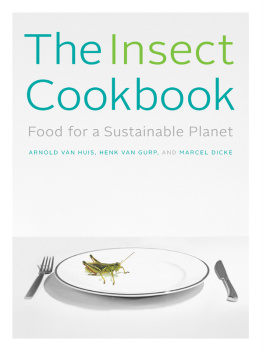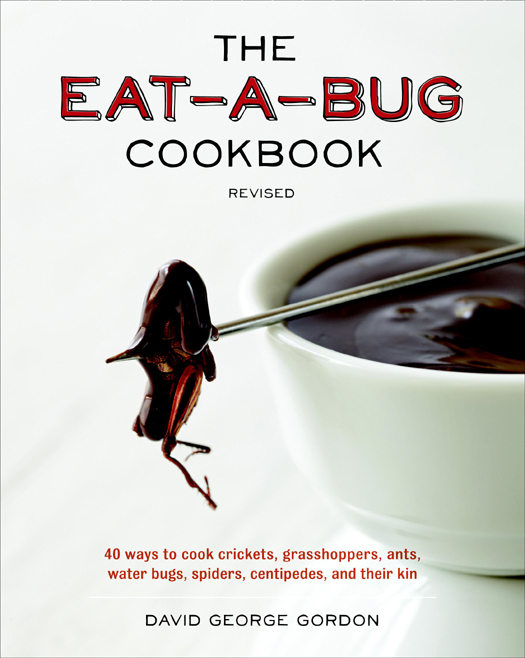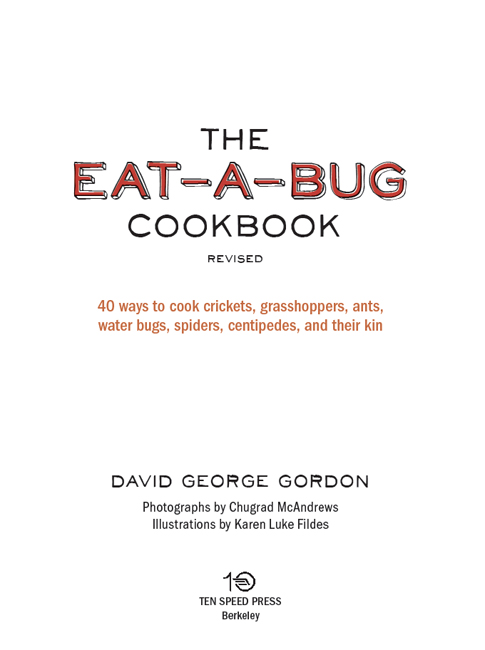Copyright 1998, 2013 by David George Gordon
Photographs copyright 2013 by Chugrad McAndrews
Illustrations copyright 2013 by Karen Luke Fildes
All rights reserved.
Published in the United States by Ten Speed Press, an imprint of the Crown Publishing Group, a division of Random House, Inc., New York.
www.crownpublishing.com
www.tenspeed.com
Ten Speed Press and the Ten Speed Press colophon are registered trademarks of Random House, Inc.
A previous edition was published in the United States by Ten Speed Press, Berkeley, in 1998.
Library of Congress Cataloging-in-Publication Data is on file with the publisher.
eBook ISBN: 978-1-60774-437-5
Trade Paperback ISBN: 978-1-60774-436-8
Author Photograph by Lila Higgins
Food and prop styling by Anne Treanor Miska
v3.1
DEDICATION
To my brother, Stuart, who first showed me
that gross can be good, and to Drew and Joe,
for showing me just how good it could be
CONTENTS
THE BUTTERFLYS BALL AND THE GRASSHOPPERS FEAST
Come, take up your hats, and away let us haste
To the Butterflys ball and the Grasshoppers feast;
The trumpeter Gad-fly has summond the crew,
And the revels are now only waiting for you.
On the smooth-shaved grass by the side of the wood,
Beneath a broad oak that for ages has stood,
See the children of the earth, and tenants of air,
For an evenings amusement together repair.
And there came the Beetle, so blind and so black,
Who carried the Emmet, his friend, on his back;
And there came the Gnat, and the Dragon-fly too,
And all their relations, green, orange, and blue.
And there came the Moth with her plumage of down,
And the Hornet with jacket of yellow and brown,
Who with him the Wasp, his companion, did bring;
They promised that evening to lay by their sting.
Then the sly little Dormouse peepd out of his hole,
And led to the feast his blind cousin the Mole;
And the Snail, with his horns peeping out of his shell,
Came fatigued with the distance, the length of an ell.
A mushroom the table, and on it were spread
A Water-dock-leaf, which their table-cloth made;
The viands were various, to each of their taste,
And the Bee brought the honey to sweeten the feast.
With steps more majestic the Snail did advance,
And he promised the gazers a minuet dance;
But they all laughed so loudly he pulled in his head,
And went in his own little chamber to bed.
Then, as the evening gave way to the shadows of night,
Their watchman, the Glow-worm, came out with his light:
So home let us hasten, while yet we can see,
For no watchman is waiting for you or for me.
William Roscoe (17531831)
ACKNOWLEDGMENTS
In the original Eat-a-Bug Cookbook , I thanked the many people who helped me, directly or indirectly, in shaping the thirty-three recipes in that book. And here I am again, fifteen years later, thanking my previous team of able bug suppliers, accomplished chefs, adventurous taste testers, assiduous editors and publishers, and authoritative arthropod lovers for their assistance. They are Mariah Bear, Paul Boyer, Sharon Collman, Lisa Darmo, Florence Dunkel, Don Ehlen, Joe Euro, T-Joe Frank, John Gautreaux, Zack Lemman, David Maxfield, Larry Peterman, Jane Peterson, Braiden Rex-Johnson, Robin Roche, Kristin, Otto, Anna, and John Smith, Louis Sorkin, Sally Sprenger, Scott Stenjem, Barney Tomberlin, and Phil Wood.
Help with this revised and updated edition came from another batch of close friends and associates, freethinkers who share my belief that insects are the food of the future, good for the environment and good for us all. This second group includes Mark Berman, Rena Chen, Mark Dennis, Meeru Dhalwala, Aaron Dossey, Art Evans, Dave Gracer, Dianne Guilfoyle, Harman Johar, Brent Karner, Steve Kutcher, Paul Landkamer, Daniella Martin, Monica Martinez, Leonard Meuse, Julieta Ramos-Elorduy, Marianne Shockley, Renzo Tomlinson, Ger van der Wal, and Rosanna Yau. I thank them for their helpful advice and heartfelt encouragement.
A final outpouring of gratitude goes to those who helped shape the work you now hold in your hands. They include Colleen Cain (book designer), Elizabeth Stromberg (art director), Emily Timberlake (editor), and Aaron Wehner (publisher), and I am indebted to them all. Im also grateful to photographer Chugrad McAndrews, food stylist Anne Treanor Miska, and my literary agent and longtime friend, Anne Depue.
I am forever appreciative of my beloved bride, Karen Luke Fildes, who contributed the illustrations in this edition and has been extremely supportive of my trip in so many ways. And I applaud my chidren for putting up with me.
Bug apptit!
INTRODUCTION
EMBRACING ENTOMOPHAGY
A Meal Moth in Every Pantry, a Chinch Bug in Every Pot
Whats this book about? Eating bugs, of course. Within these pages is everything youll need to know about bug-based cuisine, plus an assortment of tantalizing bug dishes to temptand, at times, intimidateyour family and friends.
By bugs I mean all land-dwelling arthropodsinsects, spiders, centipedes, millipedes, scorpions, and their kinthat can be caught (or otherwise acquired), cooked, and eaten. This definition may annoy some scientists who believe the word bug should be applied only to members of the insect order Hemiptera, the so-called true bugs, such as aphids or stink bugs, with mouthparts designed for sucking. Entomologically speaking, they may be right; etymologically, however, they are probably missing the point.
Four hundred years ago, when people used the word bug they meant a ghost or hobgoblina bugaboo. They used the same word to describe the bedbug, another near-invisible spirit in the dark that, incidentally, happens to be a member of the order Hemiptera. Over time, the meaning of the word expanded. Eventually bug was applied to all manner of small cold-blooded critterseven flu germs and German-made automobiles.
Bug doesnt always have a negative connotation nowadays. Ive heard diners in New Orleans call an order of boiled crayfish a plateful of bugs. My friends who are scuba divers also use this term to describe the spiny lobster, a succulent second cousin to both the crayfish and the tiger prawn.
So, why not use the word bug to identify the lobsters edible relatives on land? With the sole exception of the water bugs Lethocerus indicus and americanus , freshwater inhabitants of North America and Southeast Asia, the bugs described in this book are all terrestrial. Bugs were here many millions of years before us, and, some (including Archie the Cockroach) will inherit the earth long after were gone. In other words, look elsewhere if youre seeking recipes for shrimp creole, crab Louie, or lobster Thermidor. But read on if youd like to learn how to make Crispy Crickets, Scorpion Scaloppine, and other surprisingly satisfying fare.









